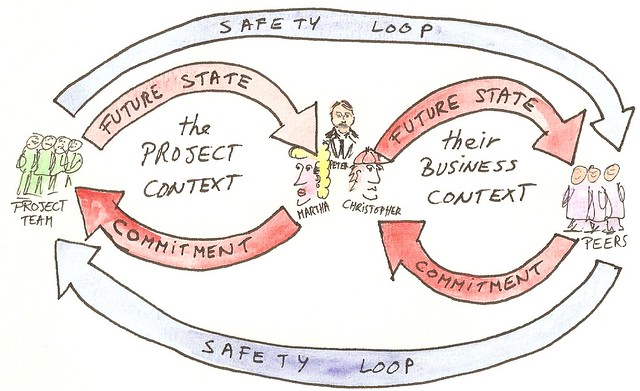Three stories of change agents going wrong and what they have in common… the fallacy of thinking that buy-in is just a single-loop.
Peter is an executive who belongs to the steering committee of the ERP initiative of his organization. Together with his team they have been working on the feasibility study, the business case and the validation of the blue-print. They’ve come a long way, because Peter and the other executives represent totally different business units with different requirements for the ERP implementation. Yet, when Peter meets with the managers of his business unit he doesn’t express the same clarity and determination as in front of the steering committee. He gives in to requests that have been declared nonnegotiable, says ‘yes’, when he ought to say ‘no’, etc.
Martha was appointed as one of the key-users in the same project. She has been a constructive ambassador of the project since the very beginning. She is putting in extra hours and during project team meetings she is the bright spot for key-users from other divisions. They love the way she shares her tips and lessons learned. She has so much to offer to other key users. Yet, when Martha is ‘out there’ in her department, her behavior seems to be different. The project team receives lengthy emails with threatening language and the whole hierarchy is cc’ed on them.
Christopher went to the user training of this very ERP implementation and upon returning he told his colleagues that the training was a disaster. His boss supports him whenever he says he has no time to engage in the preparation activities for the project. The trainers are totally surprised because in their opinion Christopher was one of the most pro-active users of the training, contributing a lot of common sense to the course. Yet, Christopher engages in lengthy explanations on why this is the most difficult time of the year to invest any time in anything else than the emergencies of his daily work. His boss agrees and the project team is not allowed to spend time with Christopher to prepare the cut-over for his department.
What’s wrong here? Why are Peter, Martha and Christopher so committed when they are with the team and why are they letting the team down when they go back to their business context?
Don’t take Buy-in for Granted
Always consider the context a person comes from when you engage someone as a ‘representative’. The fact is that when they return to their context, they may need to invalidate the commitment you have carefully built up with them. Blaming them for ‘covering their ass’ is not a good strategy. They are torn apart by imbalance in face-value they have in two different contexts.
The context of the project moves faster in building commitment for the future state because the forces that support the change are omnipresent. Also, in the context of the project, Peter, Martha and Christopher have a certain role to play. This is the face-value they hold up for themselves in the project-context. Face-value comes with the situation and it is scripted in our roles.
The context of their business unit moves slower in building commitment for the future state because the magnetic field is somewhat different. For starters, life-and-death in their daily work is not determined by project deadlines but by delivery dates to their customers. As a matter of fact the ERP project will not improve this aspect of their daily work. More to the contrary if they can believe all the stories…
Buy-in is a Double Loop Process
It turns out that buy-in is not simply a matter of evangelizing the change agents (Peter as a steerco member, Martha as a key-user and Christopher as a user).

Real buy-in is a double loop process that puts a lot of tension on the shoulders of these people. First, they need to go through the steps of building commitment in the project context. Second, we take it for granted that when they commit, their whole business unit commits together with them, in real-time.
Not.
Peter, Martha and Christopher can’t pull it off by using the project lingo and PowerPoint slides that we use in a project context. Yet we expect them to ‘be the change’. The truth is that it is unsafe for them to ‘be the change’ in front of their peers. That is where our role of organizational change practitioners is crucial. We need to go local with Peter, Martha and Christopher and help them to close the gap of commitment with their peers. Instead of asking them to ‘be the change’ we need to ‘represent the justification‘ for them to be that change.
I can only conclude that we have a tremendous responsibility when it comes to closing the second loop of the buy-in process, i.e.: making it safe for the change agents to ‘be the change’. And that is when the art of going local and the craftsmanship of social architecture come to the forefront.

